On December 10th 1869 Gebrüder Thonet voluntarily relinquished their 1856 Privilege in respect of "The manufacture of chairs and table legs made of bent wood, the bending facilitated by the action of steam or simmering liquids"; thereby ending not only a thirteen year monopoly during which time Thonet became a firmly established global brand, but also the culmination of a neigh on three decade story which highlights the importance of patent protection in the furniture industry.
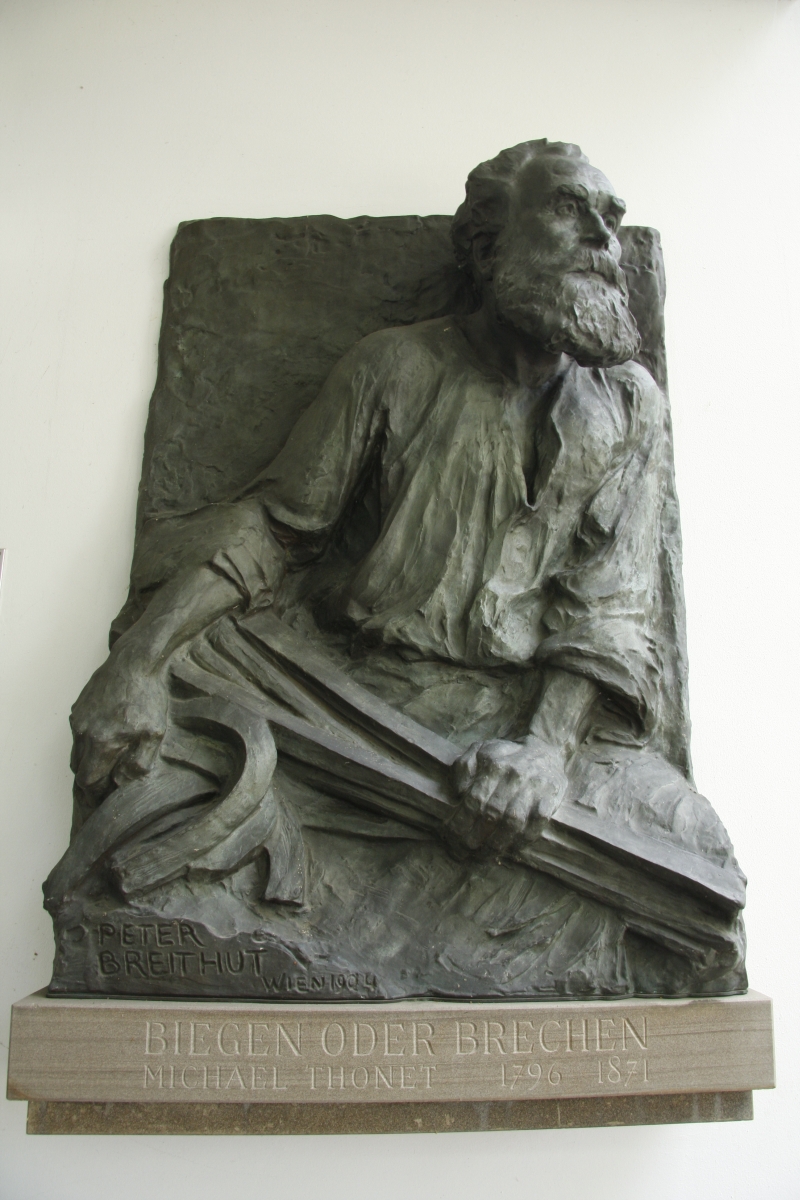
A carpenter by trade, Michael Thonet began experimenting with bending wood veneers in his native Boppard am Rhein in the early 1830s, and therefore at that period when veneer was not only becoming increasingly popular in Europe, but when the introduction of mechanised production methods was making it ever more readily and cost effectively available; as such, one can understand his experimentation as an attempt to develop processes which allowed for meaningful expressions of the potential of that material, if you will to allow carpentry to move in new directions, for all in terms of furniture production.
Following a decade of experimenting with, and producing furniture from, bent wood veneer, in 1840 Michael Thonet applied for a Privilege, a patent, in Prussia. Unsuccessfully. According to Mathias Schwartz-Clauss the responsible authority rejecting the claim "mangels Neuheit"1, "lack of novelty": bending of wood veneer wasn't itself new, but whether the Prussian authorities simply failed to recognise anything new in Thonet's application, or if there was nothing, we cannot say with any great certainty. What we can say with certainty is that other authorities took a different view and Thonet was awarded Privaleges in France, Great Britain and Belgium, Privaleges Thonet planned to sell and invest the money producing himself in Boppard2; however, Thonet either failed to find purchasers preprepared to pay an acceptable price, or the prospective purchaser wanted Michael Thonet to be involved in the day-to-day management. Which Michael Thonet didn't.3
Which all wouldn't have been quite so bad if Michael Thonet hadn't borrowed heavily to finance first his research and subsequently the Privaleges: and with no money in sight the creditors quickly became nervous and started seizing the firm's, and latterly the family's, property by way of repayment.
Which is where fate intervenes.
At an applied arts fair in Koblenz the then Austrian Chancellor Fürst Clemens von Metternich saw Thonet's work and invited Michael Thonet to his residence at Johannisberg im Rheingau to explain his process in more detail; liking what he saw and heard, Metternich gave Thonet the advice that if he wanted success he should switch Boppard for Vienna where he promised to recommend him at court.
Which he subsequently did. And he subsequently did.
Or as Otto, one feels correctly, if in somewhat overdramatic tones, opines, "Thonet's invention would have remained purely local ... if Metternich had not taken an interest in the matter, and with a measured view recognised its practical consequences and succesfully campaigned for its development and realisation"4
The latter being reference to the Austrian Privilege granted to Michael Thonet on July 16th 1842 "To bend every, even the most brittle genus of wood, in a chemical-mechanical way into any shape and curve"
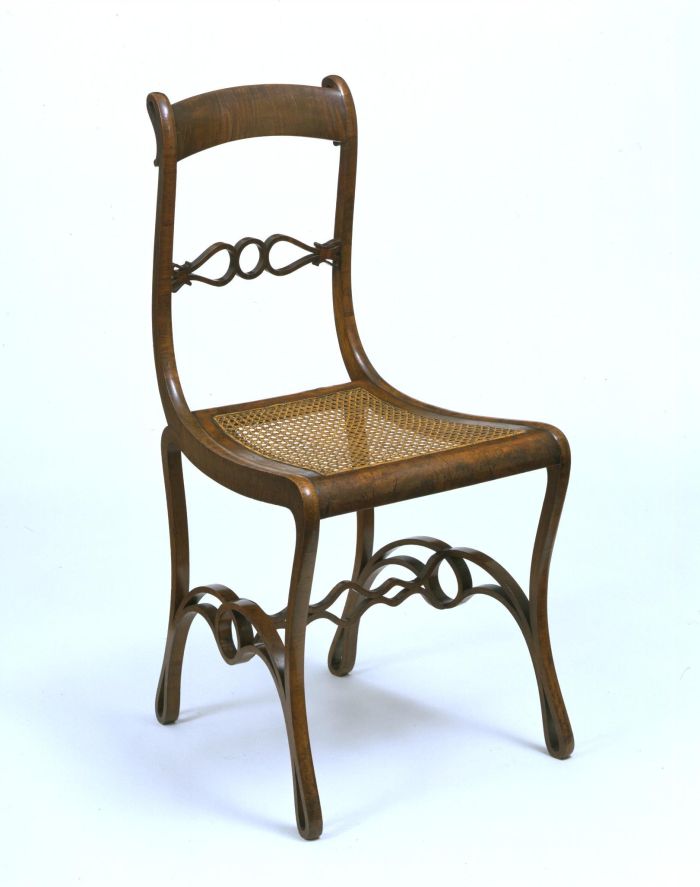
Although Michael Thonet's early years in Vienna are interesting and important in context of his biography, in the interests of brevity, and keeping the focussing on the topic in hand, we'll skip over his cooperations with Clemens List, his work on the Palais Lichtenstein and his initial commercial success in 1850 with his chair Nr. 4, and move on sprightly to 1852.
Thonet's 1842 Privilege had expired in 1847, meaning that since then he had been producing without any protection of either his processes or designs, including his increasingly popular chair Nr. 4, in many regards Thonet's "breakthrough" design. A situation which was resolved with a second Privilege in 1852 which covered "Bending wood through cutting and re-gluing to make it flexible and formable in any direction"; according to Schwartz-Clauss the 1852 Privilege was "prinipally of a commercial policy interest"5 and while we'd argue all patents are, the 1852 Privilege is a particularly good example, allowing as it did Thonet a monopoly during a period that was, in retrospect, central to the company's later development.
In 1851 Thonet had reached an international public at the London World's Fair; in 1852 business was good enough to enable the opening of a first Thonet showroom in Vienna; in 1853 Michael Thonet signed the business over to his sons, thereby not only creating Gebrüder Thonet, but also spreading both the work load and range of expertise within the company, a decision that in later years was to prove invaluable; in 1855 the company presented at the Paris Exposition Universelle where, according to Schwartz-Clauss, "for the first time orders were received from overseas, especially from South America"6; on June 17th 1856 Michael Thonet and his sons were granted Austrian citizenship. And on July 10th 1856 Gebrüder Thonet received a Privilege for "The manufacture of chairs and table legs made of bent wood, the bending facilitated by the action of steam or simmering liquids".
And thereby, and for the first time, a Privilege for the creation of furniture crafted from bent solid wood.
Which is where the Thonet story really starts to take off.
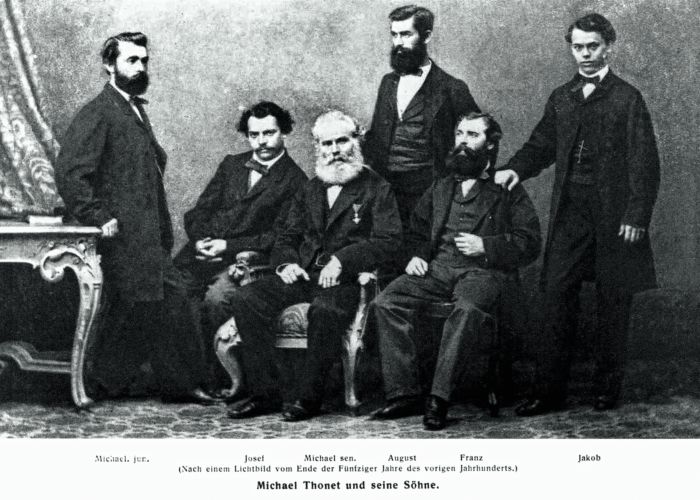
When Thonet received their Privilege in 1856 the company employed some 70 workers in the Mollardgasse in Vienna-Gumpendorf, a facility that was, by all accounts, barely able to meet the ever increasing demand; consequently, the company acquired land in Koryčany, Moravia, for the construction of a new factory. Quite aside from the necessary space afforded by the new factory, Koryčany was in a region rich in the necessary beech forests and with a ready supply of workers, both homeworkers for weaving the wicker seats and factory workers.
Since his earliest days in Boppard Thonet's construction principles had, where possible, relied on the use of standardised components which could be produced in advance and assembled as required, a production process which reached its logical conclusion with his solid wood bending process, a production process which meant, in contrast to traditional furniture production which required trained carpenters, Thonet could produce with suitably trained unskilled employees, thereby allowing for near Fordian realities, of furniture coming from production lines rather than workshops.
The age of industrial furniture production had arrived, in a village in South Moravia.
The Koryčany factory entered operation in 1857 and it was there in 1859 that Michael Thonet realised his next major coup: chair Nr. 14, the contemporary Thonet 214, and arguably the highest selling chair in the history of furniture design, if one whose real sales figures are lost in the mists of time; Thonet's contemporary figure of some 50 million may not be entirely numerically accurate, does however exactly represent the unparalleled success of the chair and the truly mind-numbing scale of its production between 1860 and the outbreak of the First World War.
And a chair whose success can be largely attributed to the fact that Thonet were able to sell the Nr. 14 for a, relatively, low price: something enabled in part by the production cost savings through its production process, in part through the fact that as Mathias Schwartz-Clauss notes until the late 1860s Thonet supplied "almost exclusively bulk buyers", and that in addition to Imperial Palaces they found their customers "principally amongst modern cafes, hotels, theaters and almost all public institutions"7, and in part by the fact they could do all that untroubled by competitors and therefore at much tighter, but still profitable, margins.
Or put another away, as Vienna began slowly transforming itself from the capital of an autocratic monarchy to that of a (wealthy middle-class) civil democracy, Thonet had a durable, lightweight, universal, mass producible, easily repairable, multi-purpose chair, which on account of the protection afforded by the 1856 Privilege could be sold at a price that made it attractive for commercial customers and thus a mass market product. In an age before mass produced, mass market products properly existed. When the 1904 Thonet catalogue refers to the Nr. 14 as the "first consumer chair" it ain't lazy marketing.
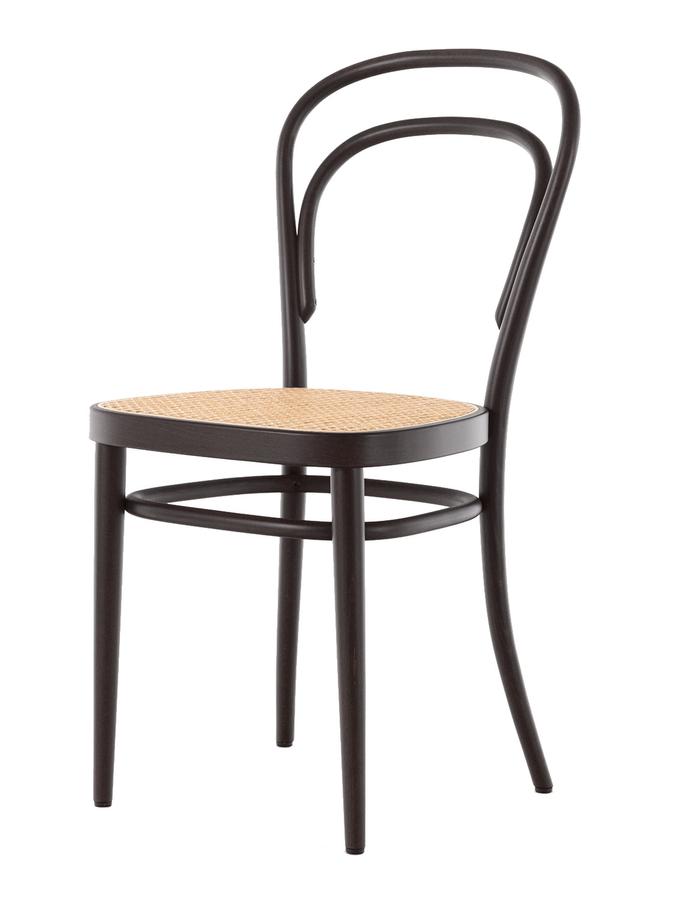
A further, contributing factor to the success of the Nr. 14 was that the patented process allowed for a global trade. Indeed Schwartz-Clauss argues that global trade was the reason for the 1856 Privilege: the foreign contracts received at the 1855 Exposition Universelle meant, logically, shipping the chairs, however, the Thonet processes practised up until then were largely based on bending glued strips of veneer, and exposure to water softened the glue, weakened the strips and led to splitting; consequently, as Exner points out, "sea transport was not compatible with Thonet's products"8
Bending solid wood solves the problem, and according to Schwartz-Clauss the move to bending solid wood was made specifically in order to ensure export; and was a move that combined with Thonet's production process allowed for the development of the famous Thonet shipping containers with 36 disassembled chair which could be shipped globally and effortlessly assembled on arrival.
And shipping containers which meant that by the time Thonet relinquished their Privilege on December 10th 1869, Thonet was not only firmly established as a leading player in the (not yet properly existant) international furniture industry, but had well established sales and distribution channels, a global network of showrooms and agents and for all the experience of working as a global company. And again, that all thanks to first the 1842 and 1852 patents which allowed Michael Thonet to establish himself, but for all Gebrüder Thonet's 1856 patent which enabled the rapid, global expansion.
So why relinquish it?
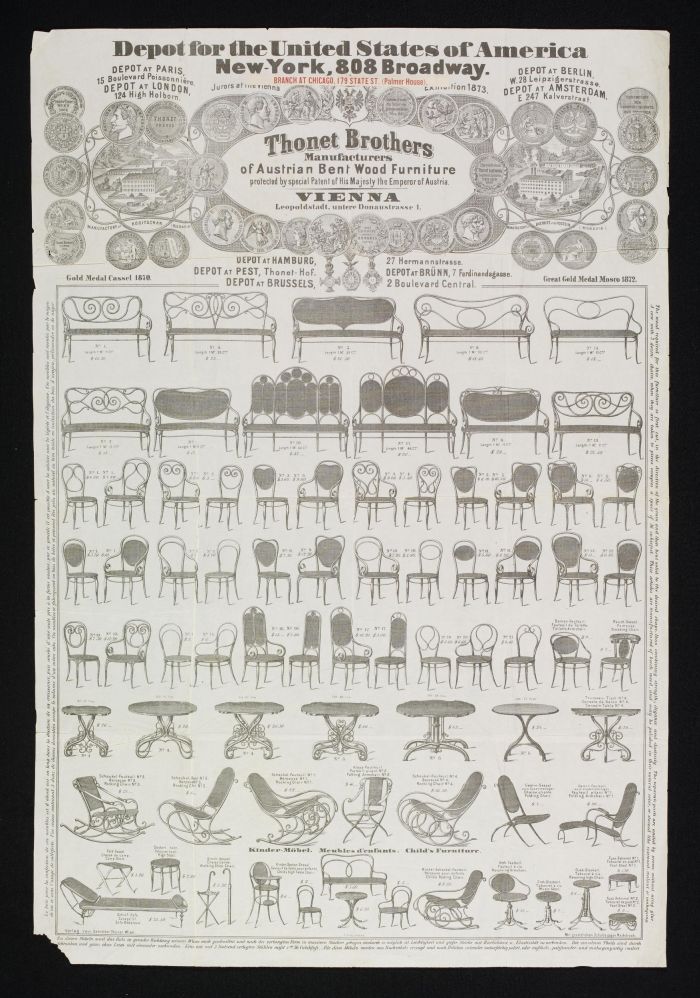
The short answer is, they had little choice.
As Jiří Uhlíř describes in great detail, in Spring 1869 the firm Jacob & Josef Kohn, so one of those companies keenest for a share of the Thonet market, filed a complaint against the 1856 Privilege with the responsible Niederösterreichischen Statthalterei, arguing "Mangel an Neuheit"9."Lack of novelty".
Which sounds very, very, familiar.......
And was indeed the chink in Thonet's armour.
Just as Michael Thonet hadn't invented bending wood veneer per se in the 1830s, with his 1856 privilege Thonet hadn't invented the bending of solid wood per se, such a process was well known to wheelwrights and shipbuilders, something in context of the 1856 Privilege application procedure Thonet had freely admitted, stating that the "new" was the adaptation to furniture.
And that is a slender, vulnerable, claim.
Especially when Kohn produced evidence of much earlier examples of solid wood bending being used for furniture production. And when a review by experts from the K.k. Mährische Statthalterei came to the conclusion on July 14th 1869 that "Accordingly, due to lack of novelty the anulling of the disputed privilege appears appropriate"10, the outcome was sealed.
The fact that Thonet gave up on their patent before it was annulled can be perhaps best understood as Uhlíř does, that while Thonet could have challenged any attempt to remove their patent in court, not only did the changing political and social realities in Vienna mean they lacked the protection a Fürst von Metternich once offered, but in addition they had a thriving company to concentrate on running, one that was expanding ever more rapidly, and that for all, "the monopoly would anyway have ended at the end of 1871. They therefore weighed both the financial and the temporal costs of a lawsuit, and the only proper solution could be the relinquishing of the privilege"11
Or put another way, the privilege had served its purpose.
And continued to do so, for although in the decades after 1869 ever more companies began with the production of bent wood furniture, none came seriously close to challenging Thonet's dominance. Or at least not until the First World War and the political and economic consequences thereof.
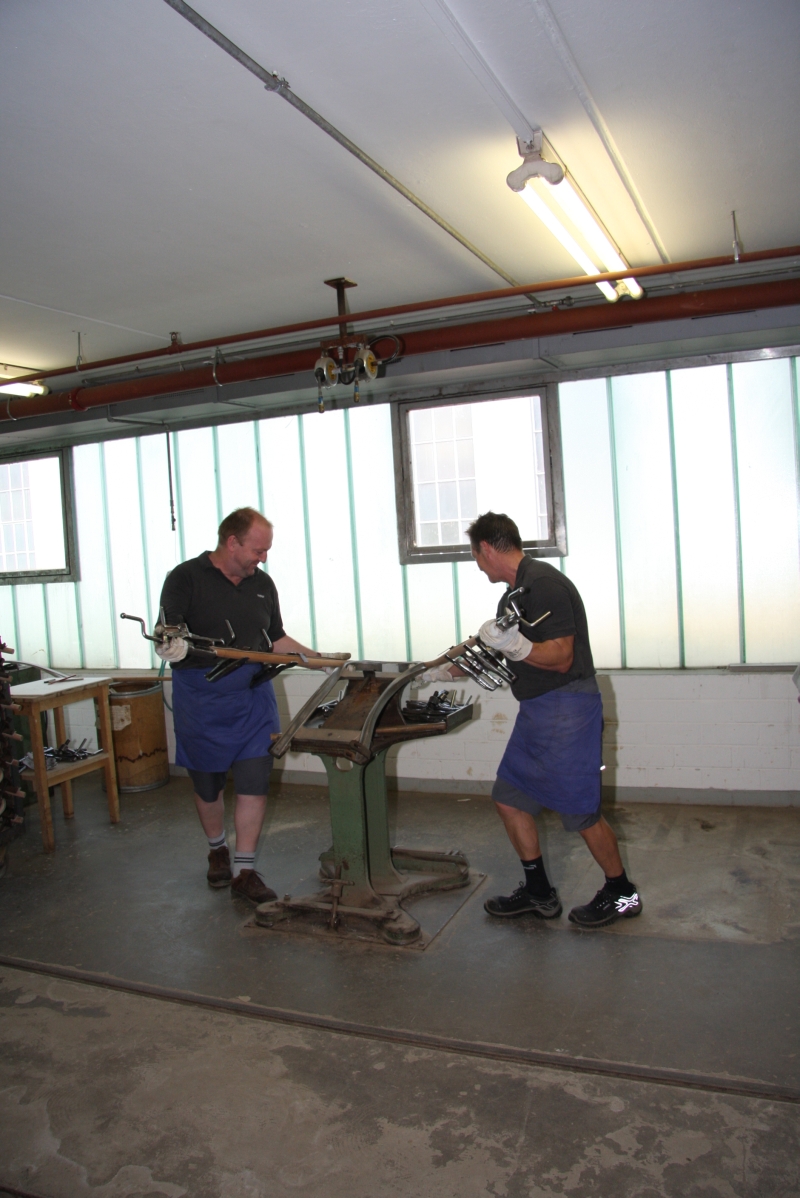
And what does the fact that Thonet lost their most important patent on account of "lack of Novelty" change about our understandings of Michael Thonet and his place in furniture history?
Nothing. Absolutely nothing.
From a technical perspective, are adoption and adaption not motors of innovation? You want to achieve something, don't know how, but know of a process that achieves something similar, and which might help. So you try it out. Adapt it for your needs. And it works. In which context there is, in our reading of the (hi)story, no direct evidence Michael Thonet was aware of the existence of the elder furniture cases uncovered by Kohn, only that he was aware of solid wood bending in other industries.
In addition there was something novel in Thonet's process, both the nature of the bending process and the devices on which the components were, and still are, bent; something, as Uhlíř notes, Thonet omitted to specifically describe in the patent, only vaguely referring to them. Had they highlighted them the Statthalterei might, perhaps, have come to a different conclusion.
Plus we'd argue, as we regularly do, that Michael Thonet's importance goes far beyond wood bending.
One the one hand there is his use of standardised components which allowed for industrial, mass, production. Solid wood bending was an essential component in his perfecting of that, but one supportive of a wider principle he had long practised.
And secondly, and centrally, there is that which Michael Thonet did with solid wood bending. For all the chairs. The path Michael Thonet took from his early chairs in Boppard until the Nr. 14 is one of a progression, of step for step moving ever further away from the more ornate, complex work of the early-19th century to much lighter, reduced, democratic objects. A path on which he remains true to himself while refining both his art and his technology. Formally little changes, the change is much more in the construction, the level of ornamentation, the relation of the components to one another and the production process. Is a progression with an inherent honesty. And a progression which not only helped drive evolving aesthetic understandings, but which also served as an inspiration for the coming generation of architects and designers, and remains so today. Reducing Michael Thonet to a process is to misunderstand his importance in the (hi)story of furniture design.
1Mathias Schwartz-Clauss, Thonet: Pionier des Industriedesigns, 1830-1900, Vitra Design Museum, Weil am Rhein,1994
2Michael Thonet; ein gedenkblatt aus anlass der hundertsten wiederkehr seines geburtstages. 2 juli 1896. Von seinen söhnen und enkeln. Druck Friedrich Jasper, Vienna, 1896
3ibid.
4Bruno Otto, Die Entwicklung der mitteleuropäischen Bugholzmöbel-Industrie, University Erlangen, Staatswiss. Diss. 1932
5Mathias Schwartz-Clauss, Thonet: Pionier des Industriedesigns, 1830-1900, Vitra Design Museum, Weil am Rhein,1994
6ibid
7ibid
8Wilhelm Franz Exner, Das Biegen des Holzes, ein für Möbelfabrikanten, Wagen- und Schiffbauer, Böttcher etc. wichtiges Verfahren: mit besonderer Rücksichtnahme auf die Thonetsche Industrie, Voigt, Weimar, 1893
9Jiří Uhlíř, Vom Wiener Stuhl zum Architektenmöbel: Jacob & Josef Kohn, Thonet und Mundus; Bugholzmöbel vom Secessionismus bis zur Zwischenkriegsmoderne, Böhlau Verlag, Vienna, 2009
10ibid.
11ibid.
That he had the Privileges, and, for so long as such existed, the favour of Imperial Vienna's ruling elite, unquestionably made it easier for Michael Thonet, as Otto notes above, allowed him to achieve his global success; but what worth patents and favour without the understanding of what you're doing, why you're doing it, where you want to take it and the resilience to achieve that?